Beirut: A birthday celebration in a war zone turned peaceful destination for the intrepid traveler
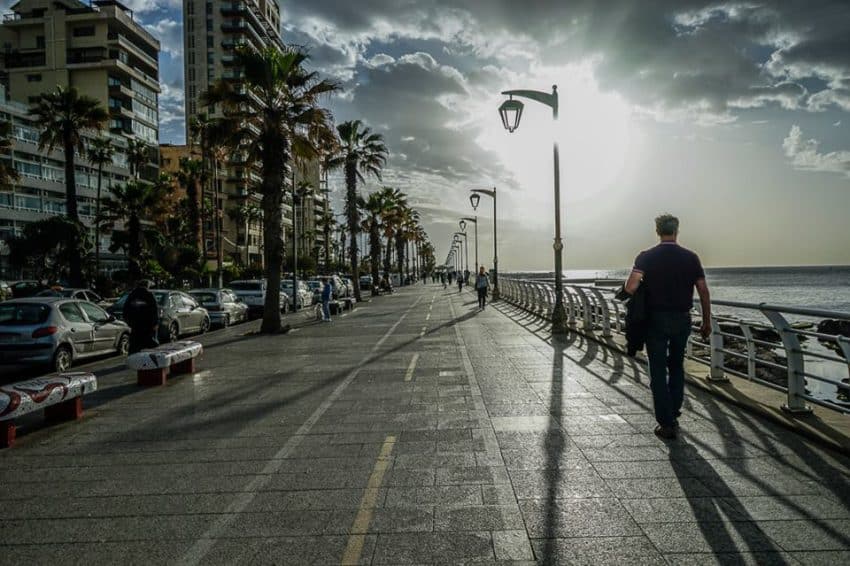
BEIRUT — The bar manager in the white suit hovered over our table by the sea. In between making Marina and I feel welcome, he directed his minions carrying buckets of white-hot coals for the hookah pipes at each table. With a 60-meter lighthouse hovering over us, we looked out through the glass-enclosed outdoor bar toward the cobalt-blue Mediterranean. Surrounding us was a smartly dressed international crowd sipping French wine, cold beer and frosty cocktails. The setting could only have been more ideal if it was under a summer sun and not spring clouds.
Then the manager blew the mood.
“I remember two Apache helicopters out there shooting at the lighthouse,” he said, pointing to the air above the sea. “Everyone dove under tables.”
Welcome to Beirut.
This is a city that has shed a violent past for a peaceful present. Nearly 30 years after a civil war that claimed 120,000 lives and displaced 76,000 others and 13 years after a one-month war with Israel, Beirut is showing signs of its heyday from the middle of the 20th century. That’s when “The Paris of the Middle East” attracted a jet set crowd who swam in a warm sea, ate great meals with views and danced until dawn.
In Beirut, it’s back to the future.

Marina shocked me once during our many discussions about future travel. She always wanted to visit Beirut. It was always on my bucket list and went higher every time I met a friendly Lebanese who raved about the new peace. A liberated, street-smart, third-generation Roman, Marina surprisingly didn’t bristle at Islam’s oft-misrepresented attitudes toward women. I knew better. I’d been to about 10 Muslim countries. Not all of them stone rape victims.
So for my recent birthday she took me to Beirut, a much more romantic destination than many Islamophobe Americans can imagine. Smoking green-apple flavored nargile (the Lebanese hookah) on a bar high atop a seaside cliff. Eating marinated chicken taouk in a 19th-century Ottoman house. Walking hand in hand along the Corniche, Beirut’s five-kilometer-long waterfront.
Our long weekend was lifted right out of “Arabian Nights,” where romantic tales are littered through stories from the Islamic Golden Age. But with every story dripping with romance, “Arabian Nights” has chapters of violence and tragedy.
So does Beirut.

As we walked back long the Corniche from that Manara Palace Cafe on the sea, we saw across the street the new Beirut. It’s a string of high-rise, modern apartment buildings all built since the end of the civil war in 1990. All had big balconies with million-dollar views of the sea to match their price tags.
But peeking out from behind the skyscrapers was the old Beirut. These buildings were gray and black monoliths, skeletal remains of the shelling that lasted from 1975-90. Collapsed balconies. Crumbling concrete. Blown-out windows. These are the memories of a war that never seems too long ago.
Beirut’s waterfront looks like Miami Beach with Aleppo as a backdrop.

We stayed right smack dab in the middle of the contradiction. Our Warwick Palm Beach Hotel is a four-star, seven-story hotel at the start of the Corniche. It boasts one of the best Indian restaurants in Beirut and a high-end cocktail lounge that was booked for private parties every night we were there.
But directly across the street occupying a narrow corner stood the remains of a triangular hotel. The vertical letters P-E-R-L-A were smoke blackened and alternated with blown-out windows. Below, its badly scarred brick wall stood next to a glitzy ad for a Moroccan massage.
We walked by this every day during our romantic walks along the Corniche. We’d both been to Havana and Miami Beach and agreed Beirut’s boardwalk — clean, scenic and diverse — topped them all. The tile walkway shined in the setting sun. Lovers walked hand in hand next to Muslim women in burqas taking selfies. Beautiful joggers in short shorts ran by. The Corniche has no sandy beach. The huge rocks below provide adequate seating and diving platforms during the steaming summer months.
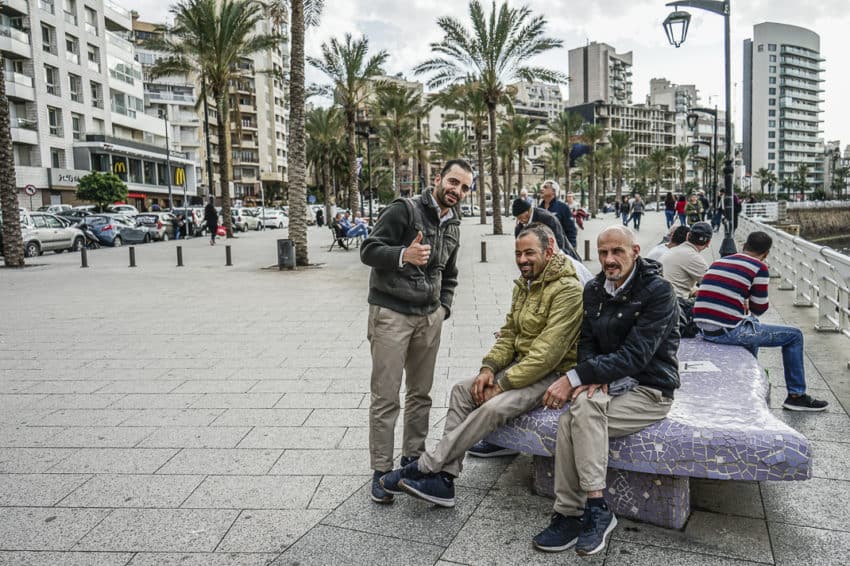
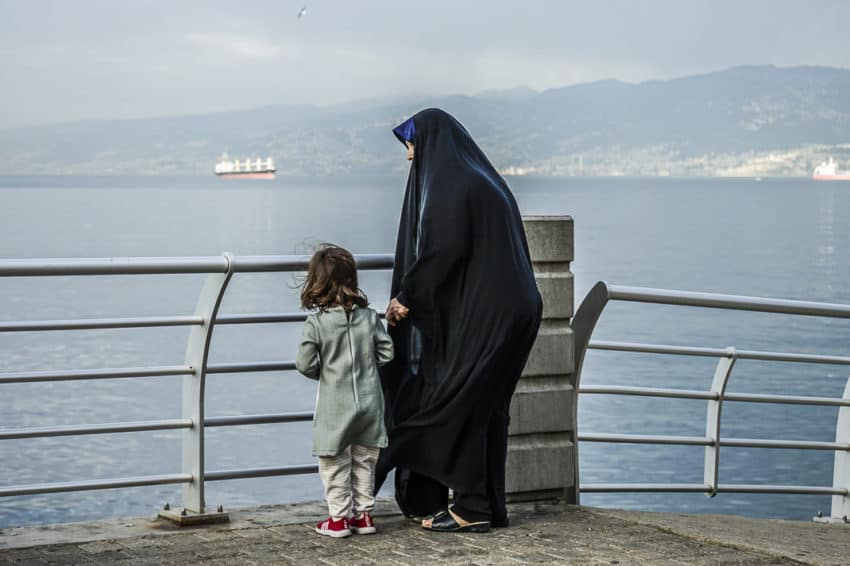

Even with steady traffic, we could hear the gentle waves lapping up against the rocks.
One day we took a taxi to the end of the Corniche and around the corner. Up a long hill were a string of cliffside restaurants, all offering incredible views of the sea. We walked into Al Falamanki Raouche, run by one of Beirut’s major bon vivants during its Golden Age. It’s filled with overstuffed couches and big chairs. We sat down by the wall and ordered apple and grapefruit nargiles. I’ve never smoked a cigarette but the nargile is slightly addicting. It’s a big brass stand about four-feet high with a container at the top holding the coals. You suck on the pipe like it’s a straw and let the “flavored water” seep into your lungs.
It’s quite tasty and after about 10 minutes of hits I admit to a touch of lightheadedness if not the wild desire to eat two kilos of hummus you get from pot. I asked the waiter if it’s unhealthy.
“It’s better than cigarettes,” he said.
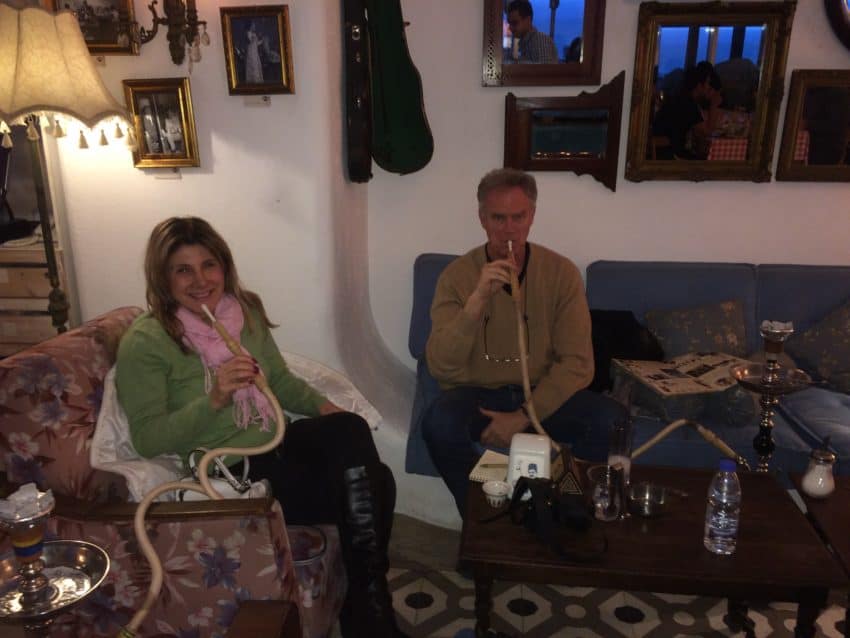
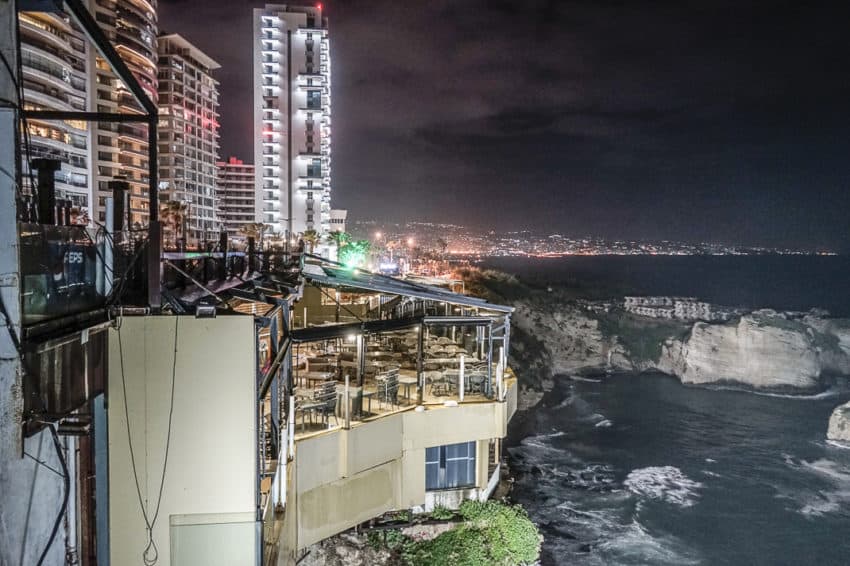
It wasn’t just sea vistas and new smoking habits that brought us to Beirut. We wanted to see the history, however ugly. We didn’t want to wander through Beirut with blinders. Surprisingly, it has no war memorial museum. There is no place to read a chronological history in photos of what happened. The Barakat building, a yellow edifice that was bombed past recognition, has been targeted as a future museum — since 2003 — but it is years from completion. No one in Beirut seems in a terrible hurry to see it happen, either. Thirty years after the war ended, it’s still not taught in Beirut schools. Talking to young Beirutis, they don’t seem to know much more than I do. They all spoke perfect English. The schools get an A for foreign languages and an F for history.
The general feeling is neither the Christian or Muslim side can decide what the correct history is. Thus, neither side is revealed, to its citizens or outsiders. It is called “state-sponsored amnesia.”
As I began my international travels in the 1970s, I followed the war from a distance. Before the war, this 5,000-year-old city stood at peace, despite a Sunni and Christian majority along the sea and a Shia minority in the south and east. In the mountains to the north lived the Druze ethnic minority.

The Christians ruled and in the mid-70s the Muslims began bristling under the pro-Western government. During the Israeli-Palestinian conflict, 100,000 Palestinians emigrated to Lebanon. The Soviet Union aligned itself with Arab countries and Lebanon’s Muslim minority. You could see some sparks starting to fly.
When the Christians and Palestinian Liberation Organization fought in ‘75, the powder keg exploded. Arab nations sided with the Muslims. Israel sided with the Christians. The war was set.
In 1989 the Tarif Agreement began the end of the fighting and in March 1991 the Lebanese Parliament pardoned all political crimes. But before then, Lebanon — a country just slightly bigger than Maryland — was the biggest war zone in the world.
Just up from the hill from our hotel stands the Holiday Inn, the famed American-based hotel that was the main symbol for East vs. West conflict and remains the most bombed building in Beirut. Both sides used the rooftop of the 26-story building to throw off opponents. Today it is a gray blight on the landscape with every window blackened like a thousand eyes that saw too much grief. Like so many other buildings, this one is owned by dueling corporations who can’t decide what to do with it.
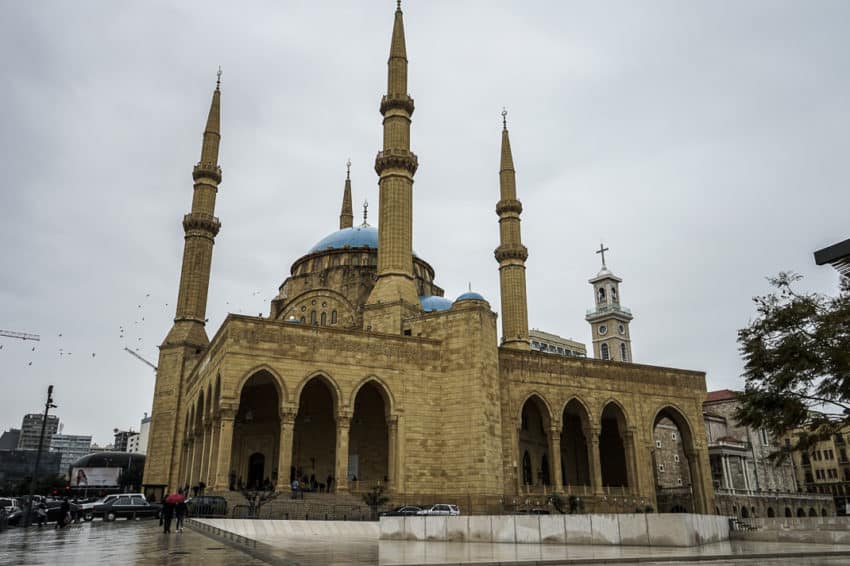
One of the prettiest buildings in the Middle East is Beirut’s Mohammad al-Amin Mosque. It’s a beautiful palace made of yellow Saudi stone with four minarets and sky blue domes. Marina and I walked inside, sans shoes, and stood on a giant red, blue and yellow Persian carpet under a six-ton glass chandelier. Next door stands St. George Greek Orthodox Cathedral, symbolic of Beirut’s current peaceful co-existence. Yet right across the street in Nehmeh Square, Martyrs’ Statue features two men, one holding a flame, and the other missing an arm — and both covered in bullet holes.
A block away stands The Egg, a huge concrete oval built in the 1960s as a proposed cinema but now is a charred, broken shell from years of civil war bombardment.

Beirut is littered with 30-year-old black eyes.
Yet talking to the people, it’s as if these sites are invisible. They’re too busy drinking, eating and dancing to talk about the past, let alone worry about it. Beirut’s nightlife may be the most underrated in the world. Who knew this former war zone has some of the best nightclubs in the world? Get up early for a pre-dawn airport taxi and you might see cafes crowded with late-night revelers eating breakfast.
I loathe nightclubs. They’re the same from Barstow to Bangkok. Instead, Marina and I went into Hamra, the neighborhood near our hotel and teeming with neighborhood bars and local restaurants. We went to one of Beirut’s best dive bars. Li Beirut is a dark, small, narrow hovel with black-and-white photos of old Lebanese musicians on the wall and soft Lebanese music playing on the loudspeaker.
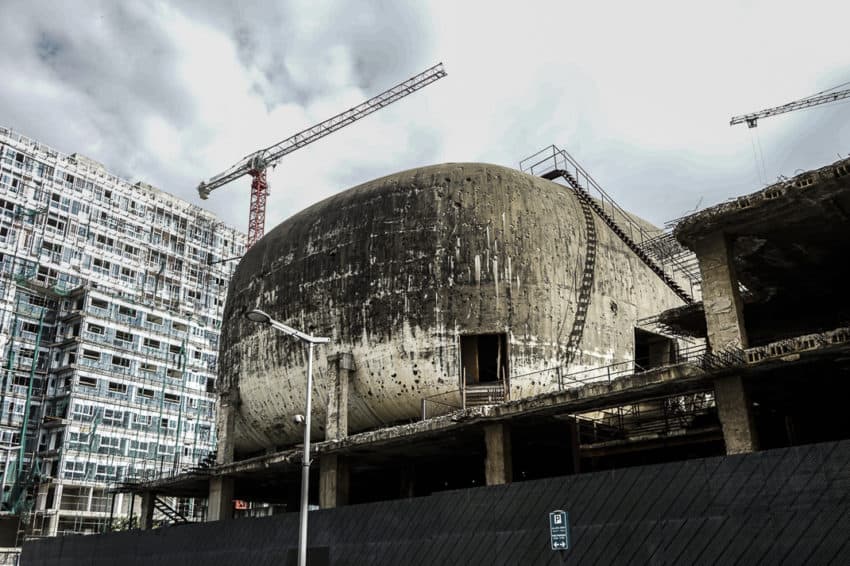
It’s here where we met our friend from Rome. Dallin Van Leuven is a 33-year-old Roberts, Idaho, native who lived in Beirut from 2016-18 as a peace-and-conflict worker for an international non-profit organization. He later married an Italian he met in Beirut and moved to Rome last year. I met him at Expats Living in Rome, Rome’s expat Meetup group. He joined the long line of Beirutis who lauded the city, from its food to its peace to its people, especially the people.
He was back in Beirut giving a lecture and Li Beirut was his old hangout. We ordered tall glasses of arak, Lebanon’s deadly licorice-flavored liqueur, and he took a savory sip.
“Beirut, not to say the rest of Lebanon, is the most alcoholic place I’ve ever been,” he said. “You can have a beer in your hand and jump in a taxi. And sometimes the taxi driver’s drinking, too.”
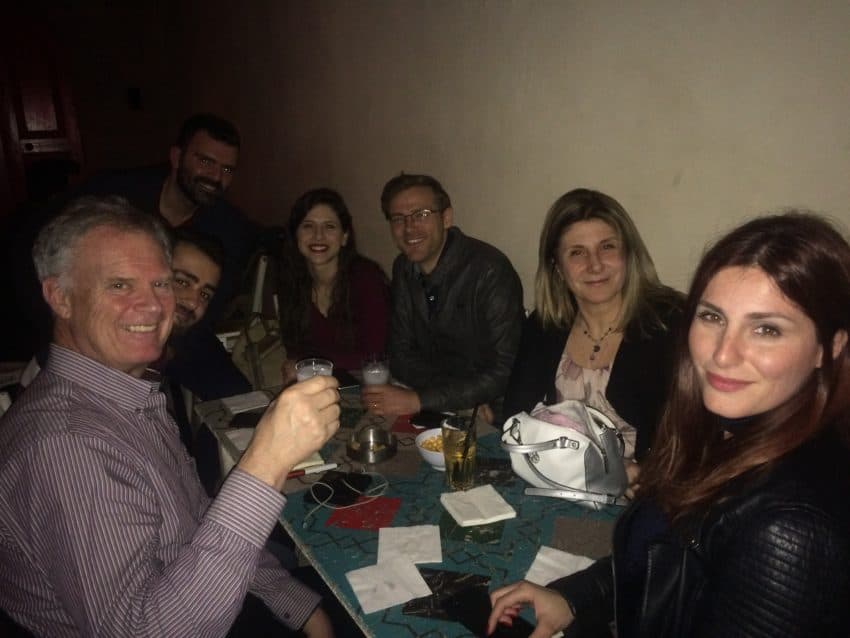
Van Leuven, who added that it is illegal to drink and drive in Lebanon, has heard all the stereotypes about Beirut. It’s as if the outside world still thinks locals are dodging mortar shells. He became part of the community. He made Lebanese friends, dated Lebanese women. This small-town Idaho boy felt at home here.
“Like most Middle Eastern countries, Lebanese people love Americans,” he said. “They have issues with American foreign policy, for sure, but they can disengage our politics from our people.”
I asked what’s the best part about living in Beirut.
“Lebanon’s a small country but it has a lot of variety,” he said. “You can hike in the mountains, can go camping on the beach, can go snorkeling, float on the river. You can do so much here. You can ski. There’s something to offer all the time.”
Lebanon also seems more open sexually. Each Muslim country has its own sexual and social mores but in Lebanon things are slowly changing. Besides women dressing as sexy as they do in Rome, attitudes are changing. During our weekend they held the 2019 Women’s Race where hundreds of women ran races of 10, 5 and 2 kilometers to raise funds for such causes as cancer awareness and Ahaad, a women’s rights NGO. That same day, Lebanon’s top military prosecutor decided not to prosecute a case of “sodomy,” stating that homosexuality is not a crime even though Lebanon’s Penal Code states, “any sexual act contrary to nature is punishable by imprisonment of one year.” Judge Peter Germanos told the Daily Star, Beirut’s English-language newspaper, that the law doesn’t spell out what’s considered “contrary to nature.”

“Homosexuality is still illegal here, but I have plenty of gay Lebanese friends who may or may not practice openly,” Van Leuven said. “It’s more accepted here but it’s still a crime. They have drag shows here.”
Soon, three of Van Leuven’s old Lebanese friends entered Li Beirut. These young people represented the new Lebanese, the upwardly mobile, outwardly friendly, English-speaking yuppies. Charbel Abou Halloun is 22 years old and hails from the northern Lebanese city of Akkar. He’s a civil engineer and moved to Beirut in 2004, well after the civil war ended.
Talking to him, he could’ve been from Milan or Santa Monica.
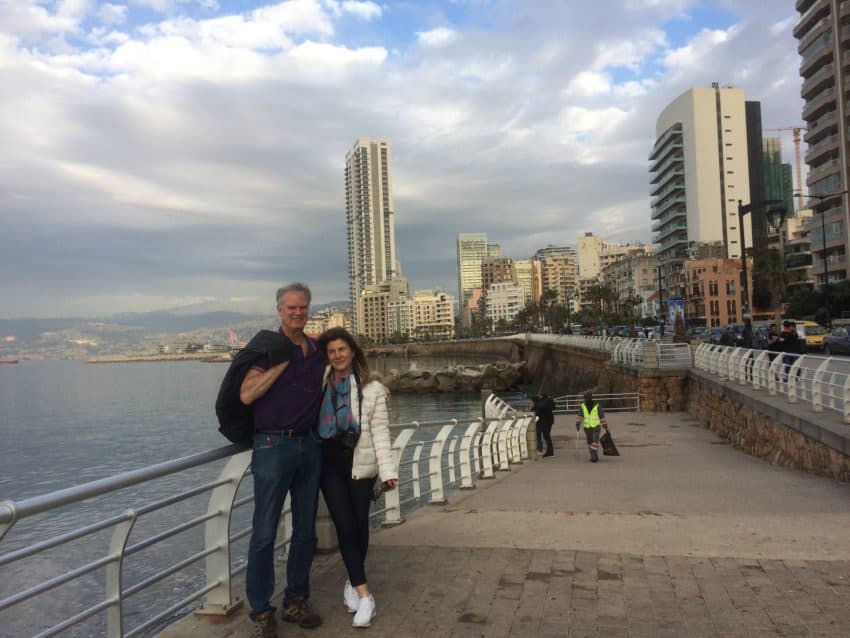
“The new generation learned from our fathers that, for example, this religion is this and this religion is that,” he said. “So we have stereotypes. We know our history. We have to live together so you forget everything and you live new. It’s our parents who had to go through the war. Not us.”
Still, the old generation has its say. Halloun is a Christian and said he couldn’t marry a Muslim woman.
“Because of my parents,” he said. “Some people, they do it but their parents don’t accept it. So they live alone without their parents’ support.”
Still, Lebanese show displays of public affection. While no man bent a woman over a fruit cart as I often see in Rome, I did see women in hijabs holding hands with men. In the spacious Main Street Cocktail Bar, Beirut’s closest thing to a sports bar, a beautiful blonde in skin-tight black leather pants nuzzled the neck of her boyfriend wearing a Yankees ballcap. She’s a Lebanese atheist divorcee.
Divorced? In Lebanon?
“Yes,” she said with a smile, “and it’s easy.”
I won’t get pollyannish on one of my new favorite countries. Lebanon still has plenty of problems. It has an $80 billion debt, third largest in the world behind Greece and Japan. Recently the head of the World Bank Middle East said the Lebanese economy “is defying gravity.” His organization won’t give a single shekel until the country fixes its electricity problem. As I read this over our hotel breakfast buffet, the lights went out.
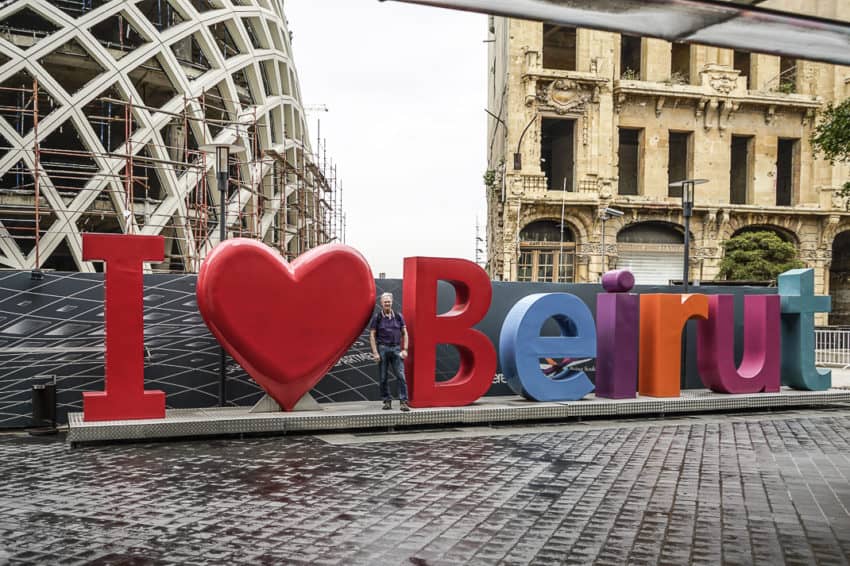
Also, Lebanon has a population of 6 million people. That includes 1.5 million Syrian refugees, 80 percent of whom have no legal status. It’s a growing source of tension among Lebanese who complain about crowded buses and drained public resources.
The plethora of political parties are fractured and stories of corruption are the worst-kept secret in town. In the wine room of the Bread Republic, a bakery oddly connected to an enoteca, I talked to three attractive Beirutis about modern life in Lebanon. They wouldn’t give their names but said life in Beirut isn’t as beautiful as it seems on a long weekend. It certainly seemed pleasant. Young, smiling, well-dressed people stood outside the wine bar sipping Lebanese and French wine.
I told them I heard Beirut’s legendary garbage problem had improved.
“That’s better,” the man said. “But we have a lot of garbage in politics you can have.”
As a traveler, you can ignore politics. However, you can’t ignore Beirut’s biggest problem: the world’s worst public transportation. It’s like Albania in 1994 after the communist government fell and the ban on cars had just been lifted. Street signs and building numbers are mere rumors. Maps are as worthless as last week’s Daily Star. Formal addresses weren’t given until after independence in 1943 and remain fairly invisible. Cab drivers know only major points of interest and drop you off in a neighborhood for you to fend on your own. GPS is highly advisable. Buses are small, old and infrequent. On a long weekend, I think we saw three.
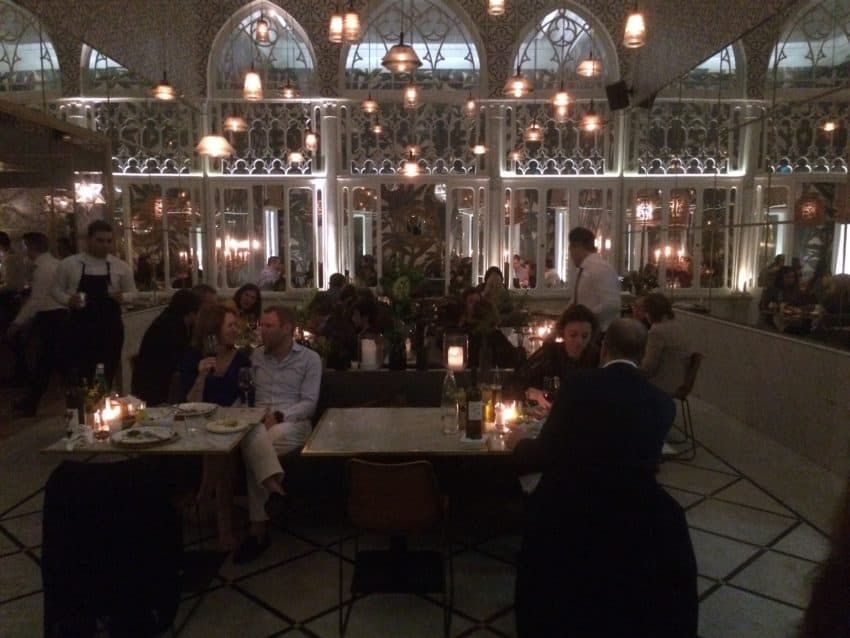
On my birthday, we went to a restaurant Conde Nast Traveler billed as “One of the most beautiful restaurants in the world.” You’d think Liza would be well known to cabbies. We had two cab drivers who had no idea where it was. Nor could they find it. Our first cab driver was a grizzled, old man with a scraggly beard and a nasty habit of spitting out his window every two blocks. He had to ask two old men on the street where it was and still couldn’t follow the directions.
We jumped out, paid him 10,000 Lebanese pounds (about $6.60) and a young driver who spoke English finally got us in the stylish, leafy Achrafieh neighborhood. After 10 minutes of driving around in circles, we got out and used Marina’s GPS to find Liza four blocks away.
The search was worth it. Lebanese food is always worth it. We are both huge fans of Middle Eastern cuisine and Lebanese is the queen of the Middle East kitchen. Sizzling lamb kabobs. Creamy hummus. Grilled meats. You can live alone off the mezes, Lebanese hors d’oeuvres that range from olives to ghanoush, mashed cooked eggplant with toasted sesame seeds.
Liza lived up to its billing. Inside a home built during the Ottoman occupation in the 19th century, Liza drips romance. Its white-decorated tables with candles sit atop elaborately tiled floors. Murals of Beirut’s skyline adorn the walls. I had halloun, pan-fried local cheese with tomato jam and sesame seeds. My entree was chicken taouk, marinated chicken with thyme and garlic. They tasted as good as they sound.

After touring the mosque we stumbled onto a wide walking mall where we had lunch at Karamna, a huge restaurant of yellow sandstone walls. Patrons smoked nargiles, filling the air with scents of green apple and jasmine. I knew Beirut had a sophisticated drinking culture when the waiter brought my Almaza, Lebanon’s national beer, in a frosted mug. We munched on mezes of carrot sticks in lemon, salt and cumin and also tabbouleh, a tangy salad of parsley, tomatoes and onions. The main course of kabob habiba was three long, lamb sausages under slabs of bread in chilies. Along with a plate of hummus for extra bread dipping, we nearly waddled out.
However, the friendly owner intercepted us and sat us at one of the outdoor tables, under cover from the rain. He brought us homemade almond saffron cookies and basil tea, all on the house. Coming from Rome where dining is more of an art than a function of life, we were blown away.

We had read Beirut is famous for its Armenian food. In fact, the entire neighborhood of Bourj Hammoud is Armenian. It has been this way since the Turkish genocide in the 1920s when Armenians flooded into the east end of Beirut and stayed. It’s a mishmash of narrow streets packed with open-air bakeries, jewelry shops and haberdashers. A blackberry bush of electrical wires hangs over every small intersection. Armenian flags and language fill the air.
The Badguer restaurant doubles as an Armenian cultural center but the restaurant is Bourj Hammoud’s main attraction. Where else can you get the delightfully named fish net kebab, meatballs in a thick wild cherry sauce and covered in pieces of fried bread? With a glass of Armenian wine, and a table full of Danish tourists nearby, we chatted with the waiter, 24-year-old Chris Koudouzian, a Lebanese-born Armenian, about Beirut’s fractured image.
“I hear this all the time: Outside Beirut people think it’s a scary place,” he said. “It’s not like all the Arabian countries. You come here to relax. Lebanon is a peaceful country now. Are we surrounded by war? Yes. But it hasn’t affected Lebanon yet.”
Despite all the attractions, Beirut doesn’t feel touristy. It remains off the beaten path and is only a mecca for the intrepid traveler. In fact, it’s hard to find a postcard, let alone souvenirs. However, we did find the perfect memory. In a little art store called Plan Bey, where they sell posters and postcards of old Lebanese films, I bought a poster of a Lebanese flag. It’s a giant photograph taken by Fouad Elkoury, a Lebanese war correspondent. It has the red and white stripes and the trademark green cedar tree. Sounds boring? It isn’t.
The flag is completely covered with bullet holes.


April 27, 2019 @ 12:01 am
Thanks for this lovely post on a beautiful and neglected city. You didn’t mention it, but the bars in Gemmayze are awesome. Regarding hookah, I would suggest taking your chances with cigarettes. Credible estimates suggest that a one hour shisha session is equivalent to about 100 cigarettes in terms of smoke, tar and nicotine.
April 27, 2019 @ 2:16 pm
Great article about a country that is definitely not on most travelers’ radar. Sounds absolutely so interesting. Loved the photos, too. Thanks, once again!!!
June 15, 2020 @ 7:07 am
Interesting article about your experience in Beirut. Dare I say though that the best part of Lebanon is to be found in its mountain villages, not in Beirut! If you go back, I recommend the Kadisha Valley and its monasteries built on cliffs (in the process of becoming UNESCO site), Becharré, Deir El Qamar, Kfar Debian and the coastal town of Byblos (UNESCO site). The Bekaa Valley has several wineries with wonderful views and the Baalbeck Ruins. L’Hôte Libanais is a chain of charming hotels in old homes that I highly recommend!
June 15, 2020 @ 7:13 am
I also should have mentioned the Jeita and Afqa grottoes, as well as Taste Lebanon, a dynamic company that will take you try the best artisan foods in the country: https://www.tastelebanon.co.uk/
and this tour operator for walks between the prettiest villages: “Living Lebanon”
Thank you 🙂
August 7, 2020 @ 11:33 pm
Although I receive notification’s from John’s blog, I was looking for something to read on Beirut. I’ve become more curious about this country after learning what they endured just a few days ago. (I also checked out Anthony Bourdain’s “No Reservations” episode on his time spent in the same city.)
John offered a wonderful, yet realistic perspective on life in this Middle-Eastern seaside city. After reading through the post, I’ve become even more curious about the people.
Thanks for a terrific read!